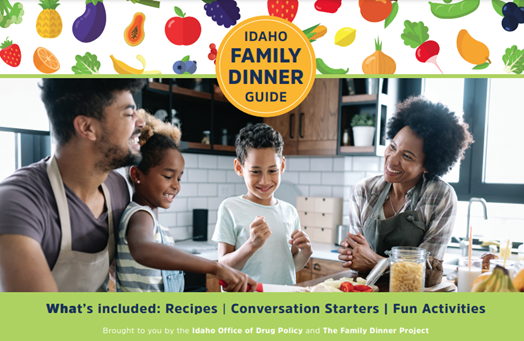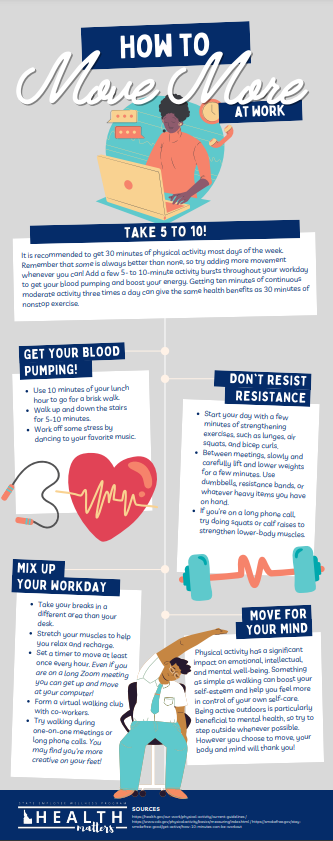Month: August 2021
Idaho Family Dinner Night 2021

Celebrate Idaho Family Dinner Night on September 27!
Eating together regularly as a family is one of the best ways to build and maintain strong relationships with your children. Frequent family dinners are linked to positive benefits for youth, including lower rates of substance use, decreased stress, higher self-esteem, and better academic performance in school.
That’s why the Office of Drug Policy (ODP) is kicking off an Idaho Family Dinner Night campaign to encourage parents across the state to celebrate Idaho Family Dinner Night on the fourth Monday of September which falls on the 27th this year. Let’s make family meals a regular event in your homes all year round.
Idaho Family Dinner Recipe Guide
To help families celebrate and connect around the dinner table, ODP created the Idaho Family Dinner Recipe Guide, which is filled with conversation starters, games and activities, and simple, budget-friendly recipes, including:
- Slow Cooker Chicken Santa Fe Soup
- Quick Trick Chicken Tacos
- 5 Minute Easy Egg Fried Rice
- Build Your Own Baked Nachos
- Baked Chicken Parmesan
To develop the Recipe Guide and share resources with parents, ODP has partnered with The Family Dinner Project, a national nonprofit initiative that champions family dinner as an opportunity for family members to connect with each other through food, fun, and conversation about things that matter. ODP is encouraging Idaho parents to sign up for The Family Dinner Project’s free online program – Food, Fun, and Conversation: 4 Weeks to Better Family Dinners – for tools and resources to help make family dinners a household staple in just four weeks.
For more information about Idaho Family Dinner Night, download the Recipe Guide, and learn how to become a family dinner pro in three easy steps, visit https://odp.idaho.gov/family-dinner-night/
Falls Aren’t Always Funny
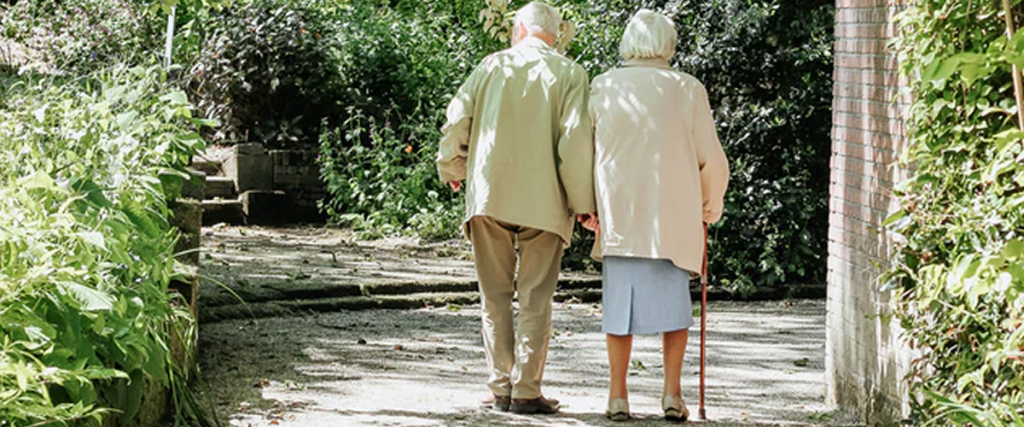
We have all seen the video where a person trips or stumbles over something and falls. When mixed with a few good sound effects, they are often humorous. It’s OK to be able to laugh at life sometimes but falls are more often than not a life-changing event, especially for older adults.
Falls are an important health concern. They often result in injuries more severe than just a scraped, bruised body and bruised ego. Falls are the #1 cause of accidental injury and death in people age 65+. Even what seems like a simple fall can lead to a trip to the emergency room or call to 9-1-1. Bone fractures and head injuries are common. Most of us are aware of the costs associated with an ER visit and other treatments but the full cost is far-reaching.
Accidental falls kill about 158 Idahoans each year at a cost of $164 million. We can easily calculate the cost from medical bills but what about lost productivity? What about the cost to have someone who takes time off work so they can take someone to medical appointments? What if that person had to hire someone for childcare while they provided transportation or in-home care? These are just the financial impacts of a fall. It is impossible to quantify loss of functionality, independence, and quality of life. For the 1 in 5 Idahoans who experiences a fall that results in significant injury, there is nothing funny about it.
These are certainly sobering statistics for those age 65+ but falling is not limited to older adults. They can happen to any of us. Are you ready for some good news? All falls are preventable. Fortunately, there are simple steps we can take to reduce the risk of falls. Invest the time now to learn how to reduce fall risk and become fall-free.
Idaho celebrates Fall Prevention Awareness Month each September!
Review and register for the four fall prevention seminars in September:
- The Importance of Fall Assessment as a Matter of Practice
- Why Falls Matter and How to Prevent Them
- Recognize and Remove Hazards at Home
- Simple Steps to Improve Balance and Prevent Falls
Descriptions, dates and registration available on the Commission for Aging website.
Take Action to Prevent Falls
It only takes a few simple steps to dramatically reduce our risk of falls. We can easily encourage others to do so as well.
- What is YOUR fall risk? Answer 12 yes/no questions to find out and get resources to help you reduce your risk.
- Are there hazards in your home? Do a safety check with this checklist to identify where to look for trip hazards and resolve them.
- Can you recover from tripping or losing balance? Stay active to maintain balance, strength, and flexibility by doing simple movements each day. Watch our Simple Steps seminar to learn more.
- Do your medications put you at more risk for falls? Ask about interactions and side-effects that may make you more prone to falling.
- Are you more likely to fall because you can’t see well? Check your vision and get correction (and wear your glasses) or learn skills to reduce misjudged steps and tripping on unseen obstacles.
Other than on TV and the movies, falls aren’t funny. Avoid the physical, mental, and financial impact of falls. Take charge of getting fall-free this fall!
Move More
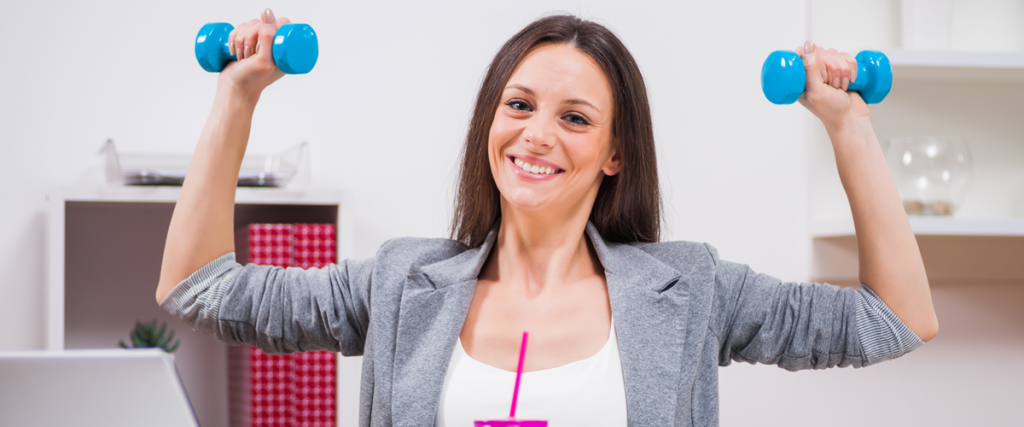
How to Move More at Work
Take 5 to 10!
It is recommended to get 30 minutes of physical activity most days of the week. Remember that some is always better than none, so try adding more movement whenever you can!
Add a few 5- to 10-minute activity bursts throughout your workday to get your blood pumping and boost your energy. Getting ten minutes of continuous moderate activity three times a day can give the same health benefits as 30 minutes of nonstop exercise.
Get Your Blood Pumping
- Use 10 minutes of your lunch hour to go for a brisk walk.
- Walk up and down the stairs for 5-10 minutes.
- Work off some stress by dancing to your favorite music.
Don’t Resist Resistance
- Start your day with a few minutes of strengthening exercises, such as lunges, air squats, and bicep curls.
- Between meetings, slowly and carefully lift and lower weights for a few minutes. Use dumbbells, resistance bands, or whatever heavy items you have on hand.
- If you’re on a long phone call, try doing squats or calf raises to strengthen lower-body muscles.
Mix Up Your Workday
- Take your breaks in a different area than your desk.
- Stretch your muscles to help you relax and recharge.
- Set a timer to move at least once every hour. Even if you are on a long Zoom meeting you can get up and move at your computer!
- Form a virtual walking club with co-workers.
- Try walking during one-on-one meetings or long phone calls. You may find you’re more creative on your feet!
Move for Your Mind
Physical activity has a significant impact on emotional, intellectual, and mental well-being. Something as simple as walking can boost yourself-esteem and help you feel more in control of your own self-care. Being active outdoors is particularly beneficial to mental health, so try to step outside whenever possible. However you choose to move, your body and mind will thank you!
More Resources for Moving More at Work
Be The 1 To
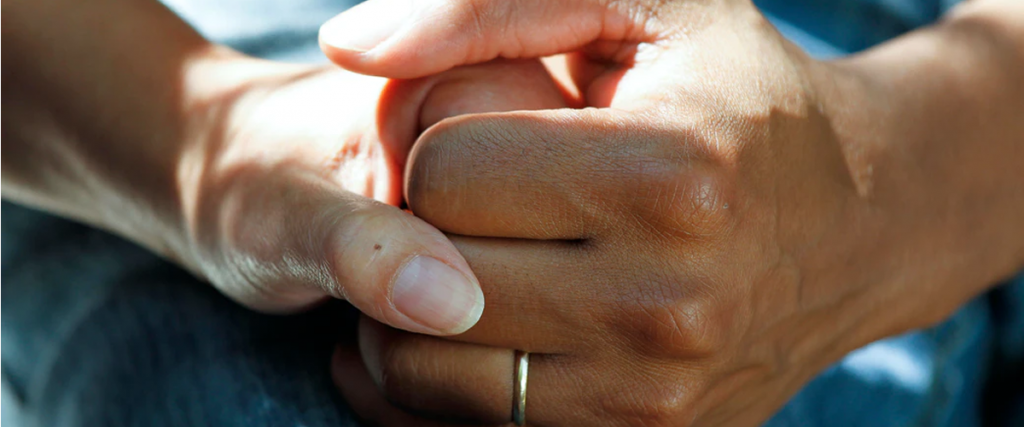
This page is not intended to and does not provide crisis intervention.
If you are currently in a crisis, or have immediate concerns about someone, call the Idaho Suicide Prevention Hotline at 208-398-4357 (HELP)
September is National Suicide Prevention Awareness Month
Suicide Prevention Awareness Month is a time to honor loved ones lost to suicide and renew efforts to prevent suicide deaths. It is also important to focus our attention on hope, help, strength, and recovery! Suicidal thoughts, much like mental health conditions, can affect anyone regardless of age, gender, or background.
We can all help prevent suicide. You can #BeThe1To save a life. The five action steps below for communicating with someone who may be thinking about suicide are supported by evidence in the field of suicide prevention.
Ask
Research shows people who are having thoughts of suicide feel relief when someone asks them in a caring way. Findings suggest acknowledging and talking about suicide may reduce rather than increase suicidal ideation.
Don’t be afraid to ask the tough question. When somebody you know is in emotional pain, ask them directly:
“Are you thinking about killing yourself?”
Be There
Individuals are more likely to feel less depressed, less suicidal, less overwhelmed, and more hopeful by speaking to someone who listens without judgment.
If this person is thinking about suicide, listen to their reasons for feeling hopeless and in pain.
Listen with compassion and empathy and without judgement.
Keep Them Safe
A number of studies have indicated that when lethal means are made less available or less deadly, suicide rates by that method decline, and frequently suicide rates overall decline.
If this person is thinking about suicide, ask if they’ve also thought about how they would do it.
Separate them from anything they are thinking of using to hurt themselves.
Help Them Connect
Studies indicate that helping someone at risk create a network of resources and individuals for support and safety can help them take positive action and reduce feelings of hopelessness.
Help this person connect to a support system so they have others to reach out to for help; whether it’s the Idaho Suicide Prevention Hotline, family, friends, clergy, coaches, co-workers, or therapists.
Follow Up
Studies have also shown that brief, low cost intervention and supportive, ongoing contact may be an important part of suicide prevention, especially for individuals after they have been discharged from hospitals or care services.
Making contact with this person in the days and weeks following a crisis can make a difference in keeping them alive.
Check in with the person you care about on a regular basis.
Become a QPR Gatekeeper to Prevent Suicide
Just like CPR, QPR is an emergency response to someone in crisis and can save lives. QPR stands for Question, Persuade, and Refer – 3 simple steps that anyone can learn to help save a life from suicide. QPR consists of three life-saving skills: recognize the warning signs of suicide; offer hope; get help and save a life. Learn more about free QPR Gatekeeper training opportunities in Idaho.
Mental Health Myths
Help bust the stigma about mental health by separating myth from fact!
MYTH: Mental health problems are rare and do not affect me.
FACT: Mental health problems are actually very common. In fact, one in four people experience a mental health issue annually. Suicide was the 8th leading cause of death among Idahoans in 2019, and Idaho has the 9th highest suicide rate in the nation. Even if you do not have a mental health problem, chances are you have a friend, family member, or co-worker who is affected.
MYTH: People with mental health problems are weak and should just “snap out of it.”
FACT: Mental health problems have nothing to do with being lazy or weak and many people need help to get better. Many factors contribute to mental health problems, including:
- Biological factors, such as genes, physical illness, injury, or brain chemistry
- Life experiences, such as trauma or a history of abuse
- Family history of mental health problems
People with mental health problems can get better and many recover completely.
MYTH: People with mental health problems are violent.
FACT: People with mental health problems are no more likely to be violent than anyone else. In fact, people with severe mental illnesses are over 10 times more likely to be victims of violent crime than the general population. This myth makes it challenging for people to talk openly about their mental health struggles. Many people with mental health problems are highly active and productive members of our communities.
MYTH: There is nothing you can do to help someone with a mental health problem.
FACT: Friends and loved ones can make a big difference. If someone you know is experiencing a mental health problem, just staying in touch can be very helpful. You can be an important influence to help someone get the treatment and services they need by:
- Reaching out and letting them know you are available to help
- Helping them access mental health services
- Learning and sharing the facts about mental health, especially if you hear something that isn’t true
- Treating them with respect, just as you would anyone else
- Refusing to define them by their diagnosis or using labels such as “crazy”
Sources: https://www.bethe1to.com/ / https://suicidepreventionlifeline.org/promote-national-suicide-prevention-month/ / https://www.mentalhealth.gov/basics/mental-health-myths-facts
Building Healthy Relationships
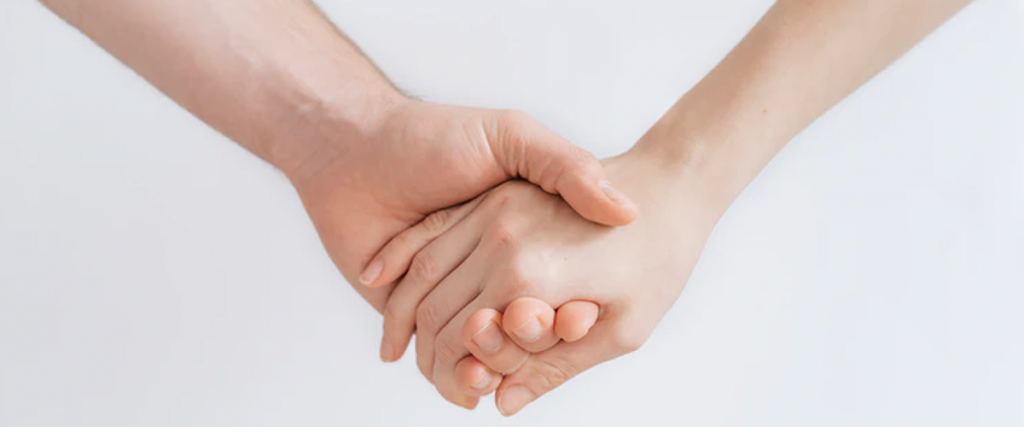
Strong, healthy relationships are important throughout your life. Your social ties with family members, friends, neighbors, coworkers, and others impact your mental, emotional, and even physical well-being.
“We can’t underestimate the power of a relationship in helping to promote well-being,” says NIH psychologist and relationship expert Dr. Valerie Maholmes. Studies have found that having a variety of social relationships may help reduce stress and heart-related risks. Strong social ties are even linked to a longer life. On the other hand, loneliness and social isolation are linked to poorer health, depression, and increased risk of early death.
As a child you learn the social skills you need to form and maintain relationships with others. But at any age you can learn ways to improve your relationships.
NIH funds research to find out what causes unhealthy relationship behavior. Researchers have created community, family, and school-based programs to help people learn to have healthier relationships. These programs also help prevent abuse and violence toward others.
What Is Healthy?
Every relationship exists on a spectrum from healthy to unhealthy to abusive. One sign of a healthy relationship is feeling good about yourself around your partner, family member, or friend. You feel safe talking about how you feel. You listen to each other. You feel valued, and you trust each other.
“It’s important for people to recognize and be aware of any time where there is a situation in their relationship that doesn’t feel right to them or that makes them feel less than who they are,” Maholmes advises.
It’s normal for people to disagree with each other. But conflicts shouldn’t turn into personal attacks. In a healthy relationship, you can disagree without hurting each other and make decisions together.
“No relationship should be based on that power dynamic where someone is constantly putting the other partner down,” Maholmes says.
If you grew up in a family with abuse, it may be hard as an adult to know what healthy is. Abuse may feel normal to you. There are several kinds of abuse, including physical, sexual, and verbal or emotional. Hurting with words, neglect, and withholding affection are examples of verbal or emotional abuse.
In an unhealthy or abusive relationship, your partner may blame you for feeling bad about something they did or said. They may tell you that you’re too sensitive. Putting you down diminishes you and keeps them in control.
In a healthy relationship, however, if you tell your partner that something they said hurt your feelings, they feel bad for hurting you. They try not to do it again.
Abuse in an intimate relationship is called domestic or intimate partner violence. This type of violence involves a pattern of behaviors used by one person to maintain power and control over someone that they are married to, living with, or dating now or in the past. A pattern means it happens over and over.
In an unhealthy or abusive relationship, you may not be allowed to spend time with family, friends, and others in your social network. “One of the signs that’s really important in relationships where there is intimate partner violence is that the partner that is being abused is slowly being isolated from family and friends and social networks,” Maholmes says. “Those social networks are protective factors.”

How to Help Someone in an Unhealthy Relationship
- Let them know that you’re worried about them.
- Listen without judging or blaming.
- Tell them that it’s not their fault.
- Offer to go with them to talk to someone who can help.
- Visit www.thehotline.org for more tips on how to help.
Social Ties Protect
Studies have shown that certain factors seem to protect people from forming unhealthy relationships over their lifetime. The protection starts early in life. NIH-supported research has shown that the quality of an infant’s emotional bond with a parent can have long-lasting positive or negative effects on the ability to develop healthy relationships.
“The early bond has implications that go well beyond the first years of life,” says Dr. Grazyna Kochanska, an NIH-funded family relationships researcher at the University of Iowa. The goal of Kochanska’s research projects is to understand the long-term effects of that early bond and to help children develop along positive pathways and avoid paths toward antisocial behaviors.
A family that functions well is central to a child’s development. Parents can help children learn how to listen, set appropriate boundaries, and resolve conflicts. Parents teach children by example how to consider other people’s feelings and act in ways to benefit others.
Secure emotional bonds help children and teens develop trust and self-esteem. They can then venture out of the family to form other social connections, like healthy friendships. In turn, healthy friendships reduce the risk of a child becoming emotionally distressed or engaging in antisocial behaviors.
On the other hand, having an unhealthy relationship in the family, including neglect and abuse, puts a child at risk for future unhealthy relationships.
“One caring adult can make a huge difference in the life of kids whose family structures may not be ideal or whose early life is characterized by abuse and neglect,” says Dr. Jennie Noll of the Center for Healthy Children at Pennsylvania State University. “That caring adult could be an older sibling, or a parent, or someone else in the family, a teacher—the kind of people who have a large influence in communicating to the child that they matter and that they’re safe, and that they have a place to go when they are needing extra support.”
Healthy friendships and activities outside of the home or classroom can play protective roles during childhood, too. In fact, everyone in a community can help support the development of healthy connections. Adults can serve as good role models for children, whether the children are their own or those they choose to mentor.
Helping and Getting Help
At any age, your relationships matter. Having healthy relationships with others starts with liking yourself. Learn what makes you happy. Treat yourself well. Know that you deserve to be treated well by others.
Having an unhealthy or abusive relationship can really hurt. The connection may be good some of the time. You may love and need the person who hurts you. After being abused, you may feel you don’t deserve to be in a healthy, loving relationship.
With help, you can work on your relationship. Or, sometimes in an abusive relationship, you may be advised to get out. Either way, others can help.
If you or a friend needs help with an unhealthy relationship, contact the National Domestic Violence Hotline at www.thehotline.org or 1-800-799-SAFE. If you know a child who may need help, find resources at the Child Welfare Information Gateway at www.childwelfare.gov.
Source: https://newsinhealth.nih.gov/2018/04/building-social-bonds
 Official Government Website
Official Government Website
